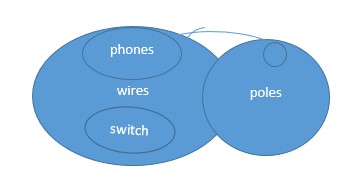Question
Statements- 1. All phones are wires. 2.
All switches are wires. 3. Some wires are poles. 4. Some poles are not phones. Conclusion- 1. All switches are poles is a possibility. 2. Some poles are not wire. 3. Some poles being phone is a possibility. In each question below there are four statement followed by three conclusion numbered 1,2 and 3. You have to take the four given statements to be true even if they seem to be at variance with commonly known facts and then decide which of the given conclusions does not follows from the four given statements, disregarding commonly known facts.Solution
All switches are wires (A) + Some wires are poles(I) ⇒ Probable conclusion ⇒ Some switches are poles (I) ⇒ Probable conclusion ⇒ All switches are poles is a possibility. Hence conclusion I follows. Some wires are poles(I) ⇒ Comversion ⇒ Some poles are wire(I). Hence conclusion II does not follow. Some poles are not phones(O) ⇒ Probable conclusion ⇒ Some poles being phone is a possibility(I). Hence conclusion III follows. Alternate Method: 
'अंश ' शब्द का विलोम है-
नीचे दिए गए वाक्यांशों और अभिव्यक्तियों के युग्मों में स�...
निमनलिकित में कौन सा अल्पप्राण व्यंजन है
'तथैव' का सही संधि-विच्छेद है:
'विद्यागृह' में कौन सा समास है?
शुद्ध वर्तनी का चयन कीजिए –
मुझ पर (1) / करें (2) / दया (3)/ हे देव (4)
वाक्य संरचना का सही क्रम �...
दक्षता का उचित पर्याय क्या होगा ?
'पीतांबर' में कौन-सा समास है?
मेरे मित्र के पास काली बिल्ली है -में रेखांकित शब्द क्...
Relevant for Exams:



